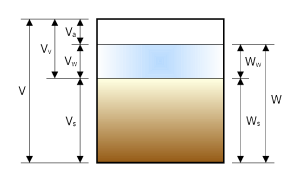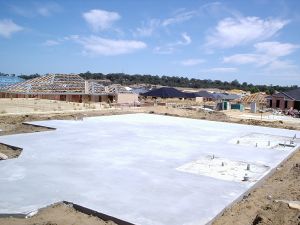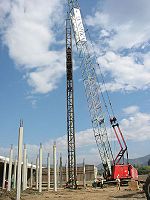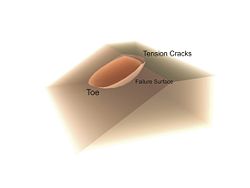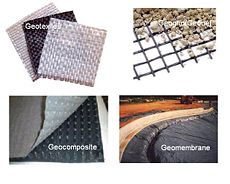Geotechnical engineering
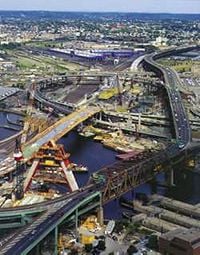
Geotechnical engineering is the branch of civil engineering concerned with the engineering behavior of earth materials. Geotechnical engineering includes investigating existing subsurface conditions and materials; determining their physical/mechanical and chemical properties that are relevant to the project considered, assessing risks posed by site conditions; designing earthworks and structure foundations; and monitoring site conditions, earthwork and foundation construction.
A typical geotechnical engineering project begins with a review of project needs to define the required material properties. Then follows a site investigation of soil, rock, fault distribution and bedrock properties on and below an area of interest to determine their engineering properties including how they will interact with, on or in a proposed construction. Site investigations are needed to gain an understanding of the area in or on which the engineering will take place. Investigations can include the assessment of the risk to humans, property and the environment from natural hazards such as earthquakes, landslides, sinkholes, soil liquefaction, debris flows, and rock falls.
A geotechnical engineer then determines and designs the type of foundations, earthworks, and/or pavement subgrades required for the intended man-made structures to be built. Foundations are designed and constructed for structures of various sizes such as high-rise buildings, bridges, medium to large commercial buildings, and smaller structures where the soil conditions do not allow code-based design.
Foundations built for above-ground structures include shallow and deep foundations. Retaining structures include earth-filled dams and retaining walls. Earthworks include embankments, tunnels, dikes, levees, channels, reservoirs, deposition of hazardous waste and sanitary landfills.
Geotechnical engineering is also related to coastal and ocean engineering. Coastal engineering can involve the design and construction of wharves, marinas, and jetties. Ocean engineering can involve foundation and anchor systems for offshore structures such as oil platforms.
The fields of geotechnical engineering and engineering geology are closely related, and have large areas of overlap. However, the field of geotechnical engineering is a specialty of engineering, where the field of engineering geology is a specialty of geology.
History
Humans have historically used soil as a material for flood control, irrigation purposes, burial sites, building foundations, and as construction material for buildings. First activities were linked to irrigation and flood control, as demonstrated by traces of dykes, dams, and canals dating back to at least 2000 B.C.E. that were found in ancient Egypt, ancient Mesopotamia and the Fertile Crescent, as well as around the early settlements of Mohenjo Daro and Arappa in the Indus valley. As the cities expanded, structures were erected supported by formalized foundations; Ancient Greeks notably constructed pad footings and strip-and-raft foundations. Until the eighteenth century, however, no theoretical basis for soil design had been developed and the discipline was more of an art than a science, relying on past experience.[1]
Several foundation-related engineering problems, such as the Leaning Tower of Pisa, prompted scientists to begin taking a more scientific-based approach to examining the subsurface. The earliest advances occurred in the development of earth pressure theories for the construction of retaining walls. Henri Gautier, a French Royal Engineer, recognized the "natural slope" of different soils in 1717, an idea later known as the soil's angle of repose. A rudimentary soil classification system was also developed based on a material's unit weight, which is no longer considered a good indication of soil type.[1][2]
Classical geotechnical mechanics began in 1773 with Charles Coulomb's introduction of mechanics to soil problems. Using the laws of friction and cohesion to determine the true sliding surface behind a retaining wall, Coulomb inadvertently defined a failure criteria for soil. By combining Coulomb's theory with Christian Otto Mohr's theory of a 2D stress state, the Mohr-Coulomb theory was developed, a very useful graphical construction still used today.
Other relevant developments during this period include: Henry Darcy's defining of hydraulic conductivity; Joseph Boussinesq's theory of stress distribution; William Rankine's simplification of Coulomb's earth pressure theory; and Albert Atterberg's examination of clay consistency.[1][2]
Modern geotechnical engineering began in 1925 with the publication of Erdbaumechanik by Karl Terzaghi. Generally recognized as the father of modern soil mechanics and geotechnical engineering, Terzaghi's research on the settlement of clays and failure due to piping beneath dams was considered groundbreaking.[1][3]
Practicing engineers
Geotechnical engineers are typically graduates of a four-year civil engineering program and often hold a masters degree. Governments usually license and regulate practicing geotechnical engineers. In the United States, state governments will typically license engineers who have graduated from an ABET accredited school, completed several years of work experience, and passed the professional engineering examination.[4] California has an additional licensing program for geotechnical engineers who have already obtained licensure as civil engineers.
Soil mechanics
In geotechnical engineering, soils are considered a three-phase material composed of: rock or mineral particles, water and air. The voids of a soil, the spaces in between mineral particles, contain the water and air.
The engineering properties of soils are affected by four main factors: the predominant size of the mineral particles, the type of mineral particles, the grain size distribution, and the relative quantities of mineral, water and air present in the soil matrix. Fine particles (fines) are defined as particles less than 0.075 mm in diameter.
Soil properties
The following properties of soils are used by geotechnical engineers in analysis of site conditions and design of earthworks, retaining structures, and foundations.
- Unit Weight
- Total unit weight: Cumulative weight of the solid particles, water and air in the material per unit volume. Note that the air phase is often assumed to be weightless.
- Dry unit weight: Weight of the solid particles of the soil per unit volume.
- Saturated unit weight: Weight of the soil when all voids are filled with water such that no air is present per unit volume. Note that this is typically assumed to occur below the water table.
- Porosity
- Ratio of the volume of voids (containing air and/or water) in a soil to the total volume of the soil expressed as a percentage. A porosity of 0 percent implies that there is neither air nor water in the soil.
- void ratio is the ratio of the volume of voids to the volume of solid particles in a soil. Void ratio is mathematically related to the porosity and is more commonly used in geotechnical formulae than porosity.
- Permeability
- A measure of the ability of water to flow through the soil, expressed in units of velocity.
- Consolidation
- As a noun, the state of the soil with regards to prior loading conditions; soils can be underconsolidated, normally consolidated or over-consolidated.
- As a verb, the process by which water is forced out of a soil matrix due to loading, causing the soil to deform, or decrease in volume, with time.
- Shear strength
- Amount of shear stress a soil can resist without failing.
- Atterberg Limits
- Liquid limit, plastic limit, and shrinkage limit, related to the plasticity of a soil. Used in estimating other engineering properties of a soil and in soil classification.
Geotechnical investigation
Geotechnical engineers perform geotechnical investigations to obtain information on the physical properties of soil and rock underlying (and sometimes adjacent to) a site to design earthworks and foundations for proposed structures, and for repair of distress to earthworks and structures caused by subsurface conditions. A geotechnical investigation will include surface exploration and subsurface exploration of a site. Sometimes, geophysical methods are used to obtain data about sites. Subsurface exploration usually involves soil sampling and laboratory testing of the soil samples retrieved.
Surface exploration can include geologic mapping, geophysical methods, and photogrammetry, or it can be as simple as an engineer walking around on the site to observe the physical conditions at the site.
To obtain information about the soil conditions below the surface, some form of subsurface exploration is required. Methods of observing the soils below the surface, obtaining samples, and determining physical properties of the soils and rock include test pits, trenching (particularly for locating faults and slide planes), borings, and cone penetration tests (CPT) or standard penetration test (SPT). CPT allows continuous recording of soil changes with depth, whereas SPT only records major changes at discrete steps of 150 mm (6 in); however, SPT allows soil sampling for laboratory testing.
Borings come in two main varieties, large-diameter and small-diameter. Large-diameter borings are rarely used due to safety concerns and expense, but are sometimes used to allow a geologist or engineer to visually and manually examine the soil and rock stratigraphy in-situ. Small-diameter borings are frequently used to allow a geologist or engineer to examine soil or rock cuttings from the drilling operation, to retrieve soil samples at depth, and to perform in-place soil tests. A cone penetration test is typically performed using an instrumented probe with a conical tip, pushed into the soil hydraulically. A basic CPT instrument reports tip resistance and frictional resistance along the friction sleeve, which is located just above the tip. CPT data has been correlated to soil properties. Sometimes instruments other than the basic CPT probe are used.
Geophysical exploration is also sometimes used; geophysical techniques used for subsurface exploration include measurement of seismic waves (pressure, shear, and Rayleigh waves), using surface-wave methods and/or downhole methods, and electromagnetic surveys (magnetometer, resistivity, and ground-penetrating radar).
Soil sampling
Soil samples are obtained in either "disturbed" or "undisturbed" condition; however, "undisturbed" samples are not truly undisturbed. A disturbed sample is one in which the structure of the soil has been changed sufficiently that tests of structural properties of the soil will not be representative of in-situ conditions, and only properties of the soil grains can be accurately determined. An undisturbed sample is one where the condition of the soil in the sample is close enough to the conditions of the soil in-situ to allow tests of structural properties of the soil to be used to approximate the properties of the soil in-situ.
Soil samples may be gathered using a variety of samplers; some provide only disturbed samples, while others can provide relatively undisturbed samples. Samples can be obtained by methods as simple as digging out soil from the site using a shovel. Samples taken this way are disturbed samples. More sophisticated sampling methods include split-spoon samplers, piston samplers, and pushed samplers. The standard penetration test (SPT) sampler is a split-spoon sampler, and there are similar samplers with larger sample-barrels. The SPT test returns a sample as well as providing in-situ soil data. SPT samples are disturbed samples, but samples from larger split-spoon samplers can be considered relatively undisturbed. Piston samplers are thin-walled metal tubes which contain a piston at the tip. The samplers are pushed into the bottom of a borehole, with the piston remaining at the surface of the soil while the tube slides past it. These samplers will return undisturbed samples in soft soils, but are difficult to advance in sands and stiff clays, and can be damaged (compromising the sample) if gravel is encountered. The pitcher barrel sampler is a direct-push sampler similar to piston samplers, except that there is no piston. There are pressure-relief holes near the top of the sampler to prevent pressure buildup of water or air above the soil sample.
Laboratory tests
A wide variety of laboratory tests can be performed on soils to measure a wide variety of soil properties. Some soil properties are intrinsic to the composition of the soil matrix and are not affected by sample disturbance, while other properties depend on the structure of the soil as well as its composition, and can only be effectively tested on relatively undisturbed samples. Some soil tests measure direct properties of the soil, while others measure "index properties" which provide useful information about the soil without directly measuring the property desired. Some of the more commonly performed laboratory tests include: Atterberg limits, California bearing ratio, hydraulic conductivity, consolidation, particle-size analysis, soil compaction, triaxial shear, unconfined compression, density index (called relative density in USA) and water content tests..
Foundations
A building's foundation transmits loads from buildings and other structures to the earth. Geotechnical engineers design foundations based on the load characteristics of the structure and the properties of the soils and/or bedrock at the site. In general, geotechnical engineers: 1) estimate the magnitude and location of the loads to be supported; 2) develop an investigation plan to explore the subsurface; 3) determine necessary soil parameters through field and lab testing (for example, consolidation test, triaxial shear test, vane shear test, standard penetration test); and 4) design the foundation in the safest and most economical manner.
The primary considerations for foundation support are bearing capacity, settlement, and ground movement beneath the foundations. Bearing capacity is the ability of the site soils to support the loads imposed by buildings or structures. Settlement occurs under all foundations in all soil conditions, though lightly loaded structures or rock sites may experience negligible settlements. For heavier structures or softer sites, both overall settlement relative to unbuilt areas or neighboring buildings, and differential settlement under a single structure, can be concerns. Of particular concern is settlement which occurs over time, as immediate settlement can usually be compensated for during construction. Ground movement beneath a structure's foundations can occur due to shrinkage or swell of expansive soils due to climatic changes, frost expansion of soil, melting of permafrost, slope instability, or other causes. All these factors must be considered during design of foundations.
Many building codes specify basic foundation design parameters for simple conditions, frequently varying by jurisdiction, but such design techniques are normally limited to certain types of construction and certain types of sites, and are frequently very conservative.
In areas of shallow bedrock, most foundations may bear directly on bedrock; in other areas, the soil may provide sufficient strength for the support of structures. In areas of deeper bedrock with soft overlying soils, deep foundations are used to support structures directly on the bedrock; in areas where bedrock is not economically available, stiff "bearing layers" are used to support deep foundations instead.
Shallow foundations
Shallow foundations are a type of foundation that transfers building load to the very near the surface, rather than to a subsurface layer. Shallow foundations typically have a depth to width ratio of less than 1.
Footings
Footings (often called "spread footings" because they spread the load) are structural elements which transfer structure loads to the ground by direct areal contact. Footings can be isolated footings for point or column loads, or strip footings for wall or other long (line) loads. Footings are normally constructed from reinforced concrete cast directly onto the soil, and are typically embedded into the ground to penetrate through the zone of frost movement and/or to obtain additional bearing capacity.
Slab foundations
A variant on spread footings is to have the entire structure bear on a single slab of concrete underlying the entire area of the structure. Slabs must be thick enough to provide sufficient rigidity to spread the bearing loads somewhat uniformly, and to minimize differential settlement across the foundation. In some cases, flexure is allowed and the building is constructed to tolerate small movements of the foundation instead. For small structures, like single-family houses, the slab may be less than 30cm thick; for larger structures, the foundation slab may be several meters thick.
Slab foundations can be either slab-on-grade foundations or embedded foundations, typically in buildings with basements. Slab-on-grade foundations must be designed to allow for potential ground movement due to changing soil conditions.
Deep foundations
Deep foundations are used for structures or heavy loads when shallow foundations cannot provide adequate capacity, due to size and structural limitations. They may also be used to transfer building loads past weak or compressible soil layers. While shallow foundations rely solely on the bearing capacity of the soil beneath them, deep foundations can rely on end bearing resistance, frictional resistance along their length, or both in developing the required capacity. Geotechnical engineers use specialized tools, such as the cone penetration test, to estimate the amount of skin and end bearing resistance available in the subsurface.
There are many types of deep foundations including piles, drilled shafts, caissons, piers, and earth stabilized columns. Large buildings such as skyscrapers typically require deep foundations. For example, the Jin Mao Tower in China uses tubular steel piles about 1m (3.3 feet) driven to a depth of 83.5m (274 feet) to support its weight.
In buildings that are constructed and found to undergo settlement, underpinning piles can be used to stabilize the existing building.
Lateral earth support structures
A retaining wall is a structure that holds back earth. Retaining walls stabilize soil and rock from downslope movement or erosion and provide support for vertical or near-vertical grade changes. Cofferdams and bulkheads, structures to hold back water, are sometimes also considered retaining walls.
The primary geotechnical concern in design and installation of retaining walls is that the retained material is attempting to move forward and downslope due to gravity. This creates soil pressure behind the wall, which can be analyzed based on the angle of internal friction (φ) and the cohesive strength (c) of the material and the amount of allowable movement of the wall. This pressure is smallest at the top and increases toward the bottom in a manner similar to hydraulic pressure, and tends to push the wall forward and overturn it. Groundwater behind the wall that is not dissipated by a drainage system causes an additional horizontal hydraulic pressure on the wall.
Gravity Walls
Gravity walls depend on the size and weight of the wall mass to resist pressures from behind. Gravity walls will often have a slight setback, or batter, to improve wall stability. For short, landscaping walls, gravity walls made from dry-stacked (mortarless) stone or segmental concrete units (masonry units) are commonly used.
Earlier in the twentieth century, taller retaining walls were often gravity walls made from large masses of concrete or stone. Today, taller retaining walls are increasingly built as composite gravity walls such as: geosynthetic or steel-reinforced backfill soil with precast facing; gabions (stacked steel wire baskets filled with rocks), crib walls (cells built up log cabin style from precast concrete or timber and filled with soil) or soil-nailed walls (soil reinforced in place with steel and concrete rods).
For reinforced-soil gravity walls, the soil reinforcement is placed in horizontal layers throughout the height of the wall. Commonly, the soil reinforcement is geogrid, a high-strength polymer mesh, that provide tensile strength to hold soil together. The wall face is often of precast, segmental concrete units that can tolerate some differential movement. The reinforced soil's mass, along with the facing, becomes the gravity wall. The reinforced mass must be built large enough to retain the pressures from the soil behind it. Gravity walls usually must be a minimum of 50 to 60 percent as deep (thick) as the height of the wall, and may have to be larger if there is a slope or surcharge on the wall.
Cantilever walls
Prior to the introduction of modern reinforced-soil gravity walls, cantilevered walls were the most common type of taller retaining wall. Cantilevered walls are made from a relatively thin stem of steel-reinforced, cast-in-place concrete or mortared masonry (often in the shape of an inverted T). These walls cantilever loads (like a beam) to a large, structural footing; converting horizontal pressures from behind the wall to vertical pressures on the ground below. Sometimes cantilevered walls are buttressed on the front, or include a counterfort on the back, to improve their stability against high loads. Buttresses are short wing walls at right angles to the main trend of the wall. These walls require rigid concrete footings below seasonal frost depth. This type of wall uses much less material than a traditional gravity wall.
Cantilever walls resist lateral pressures by friction at the base of the wall and/or passive earth pressure, the tendency of the soil to resist lateral movement.
Basements are a form of cantilever walls, but the forces on the basement walls are greater than on conventional walls because the basement wall is not free to move.
Excavation shoring
Shoring of temporary excavations frequently requires a wall design which does not extend laterally beyond the wall, so shoring extends below the planned base of the excavation. Common methods of shoring are the use of sheet piles or soldier beams and lagging. Sheet piles are a form of driven piling using thin interlocking sheets of steel to obtain a continuous barrier in the ground, and are driven prior to excavation. Soldier beams are constructed of wide flange steel H sections spaced about 2-3 m apart, driven prior to excavation. As the excavation proceeds, horizontal timber or steel sheeting (lagging) is inserted behind the H pile flanges.
In some cases, the lateral support which can be provided by the shoring wall alone is insufficient to resist the planned lateral loads; in this case additional support is provided by walers or tie-backs. Walers are structural elements which connect across the excavation so that the loads from the soil on either side of the excavation are used to resist each other, or which transfer horizontal loads from the shoring wall to the base of the excavation. Tie-backs are steel tendons drilled into the face of the wall which extend beyond the soil which is applying pressure to the wall, to provide additional lateral resistance to the wall.
Earth structures
- Pavements
- Embankments
- Reservoirs
- Engineered Slopes
Slope stability
Slope stability is the analysis of soil covered slopes and its potential to undergo movement. Stability is determined by the balance of shear stress and shear strength. A previously stable slope may be initially affected by preparatory factors, making the slope conditionally unstable. Triggering factors of a slope failure can be climatic events can then make a slope actively unstable, leading to mass movements. Mass movements can be caused by increases in shear stress, such as loading, lateral pressure, and transient forces. Alternatively, shear strength may be decreased by weathering, changes in pore water pressure, and organic material.
Geosynthetics
Geosynthetics is the umbrella term used to describe a range of synthetic products used to aid in solving some geotechnical problems. The term is generally regarded to encompass four main products; geotextiles, geogrids, geomembranes, and geocomposites. The synthetic nature of the products make them suitable for use in the ground where high levels of durability are required, this is not to say that they are indestructible. Geosynthetics are available in a wide range of forms and materials, each to suit a slightly different end use. These products have a wide range of applications and are currently used in many civil and geotechnical engineering applications including roads, airfields, railroads, embankments, retaining structures, reservoirs, canals, dams, landfills, bank protection and coastal engineering
| ||||||||||||||||||||||||||||||||||||||
See also
- Civil engineering
- Earthquake
- Geology
- Geomorphology
- Landfill
- Rock (geology)
- Sediment
- Seismology
- Soil
- Karl von Terzaghi
- Land reclamation
- Soil science
Notes
- ↑ 1.0 1.1 1.2 1.3 Braja Das, Principles of Geotechnical Engineering (Garden Grove, CA: Nelson, 2006, ISBN 9780534551445).
- ↑ 2.0 2.1 Muni Budhu, Soil Mechanics and Foundations (New York, NY: John Wiley & Sons, Inc., 2007, ISBN 9780471252313).
- ↑ T. William Lambe and Robert V. Whitman, Soil Mechanics (New York, NY: John Wiley & Sons, ISBN 9780471511922).
- ↑ NCEES, Licensure for Engineers. Retrieved December 18, 2008.
ReferencesISBN links support NWE through referral fees
- Bowles, J. 1988. Foundation Analysis and Design. New York, NY: McGraw-Hill Publishing Company. ISBN 0070067767.
- Cedergren, Harry R. 1977. Seepage, Drainage, and Flow Nets. New York, NY: Wiley. ISBN 0471141798.
- Fang, H.Y., and J. Daniels. 2005. Introductory Geotechnical Engineering: An Environmental Perspective. London, UK: Taylor & Francis. ISBN 0415304024.
- Freeze, R.A., and J.A. Cherry. 1979. Groundwater. Englewood Cliffs, NJ: Prentice-Hall. ISBN 0133653129.
- Holtz, R. and W. Kovacs. 1981. An Introduction to Geotechnical Engineering. Englewood Cliffs, NJ: Prentice-Hall, Inc. ISBN 0134843940.
- Kramer, Steven L. 1996. Geotechnical Earthquake Engineering. Englewood Cliffs, NJ: Prentice-Hall, Inc. ISBN 0133749436.
- Mitchell, James K., and K. Soga. 2005. Fundamentals of Soil Behavior, 3rd ed. Hoboken, NJ: John Wiley & Sons, Inc. ISBN 9780471463023.
- NAVFAC (Naval Facilities Engineering Command). 1986. Design Manual 7.01, Soil Mechanics. Alexandria, VA: Naval Facilities Engineering Command.
- NAVFAC (Naval Facilities Engineering Command). 1986. Design Manual 7.02, Foundations and Earth Structures. Alexandria, VA: Dept. of the Navy, Naval Facilities Engineering Command.
- NAVFAC (Naval Facilities Engineering Command). 1983. Design Manual 7.03, Soil Dynamics, Deep Stabilization and Special Geotechnical Construction. Alexandria, VA: Dept. of the Navy, Naval Facilities Engineering Command.
- Rajapakse, Ruwan. 2005. Pile Design and Construction. Maplewood, NJ: R. Rajapakse. ISBN 0972865713.
- Terzaghi, K., R.B. Peck, and Mesri, G. 1996. Soil Mechanics in Engineering Practice, 3rd Ed. New York, NY: John Wiley & Sons, Inc. ISBN 0471086584.
Credits
New World Encyclopedia writers and editors rewrote and completed the Wikipedia article in accordance with New World Encyclopedia standards. This article abides by terms of the Creative Commons CC-by-sa 3.0 License (CC-by-sa), which may be used and disseminated with proper attribution. Credit is due under the terms of this license that can reference both the New World Encyclopedia contributors and the selfless volunteer contributors of the Wikimedia Foundation. To cite this article click here for a list of acceptable citing formats.The history of earlier contributions by wikipedians is accessible to researchers here:
The history of this article since it was imported to New World Encyclopedia:
Note: Some restrictions may apply to use of individual images which are separately licensed.
